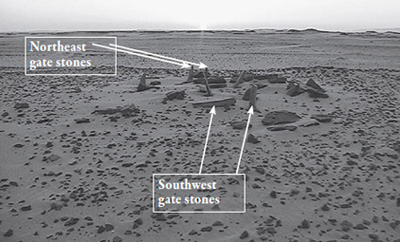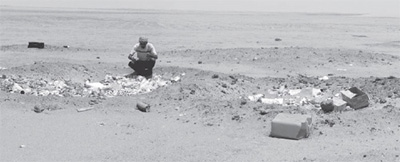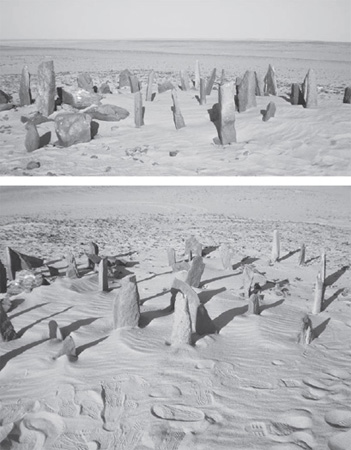Black Genesis (36 page)

APPENDIX 3
SAVING NABTA PLAYA

Will the Oldest Prehistoric Astronomical Complex in the World Be Destroyed?
In July 1998, a short letter published in the highly respected scientific journal
Nature
sent a huge wave of interest across scientific communities worldwide. Professor Fred Wendorf, an American anthropologist, and his colleagues, astronomer Kim Malville and fellow anthropologist Romuald Schild, made a startling announcement: they had discovered in Egypt's Western Desert, at a location 100 kilometers (62 miles) west of Abu Simbel, the oldest astronomical megalithic site in the world, predating Stonehenge by at least one thousand years. They called the site Nabta Playa. Wendorf and his team then concluded that the African-origin prehistoric people of Nabta Playa were most probably the ancestors of the pharaohs, and it was them, with their well-developed knowledge of astronomy, agriculture, and cattle-herding, who provided the impetus that inspired the great civilization of ancient Egypt.
The news went around the world like wildfire, and soon many academics were becoming convinced that it was, indeed, in the Western Desert of Egypt (also called the Eastern Sahara or Egyptian Sahara) that civilization began and, eventually, in the fourth millennium BCE spread to the adjacent Nile Valley, where it then spawned the pharaonic culture. In view of this realization, Nabta Playa acquired immense importance for the study of the origins of civilization as well as other elements of early humans, such as astronomy, the domestication of cattle, the development of agriculture, and early religious ideologies. A team headed by Fred Wendorf, calling itself the Combined Prehistoric Expedition (CPE) was allocated a concession by the Supreme Council of Antiquities of Egypt (SCA) to study and excavate at Nabta Playa.
In fact, Nabta Playa was discovered in 1974 by Wendorf and his team, but it was not until the early 1990s that they realized that the many megaliths strewn about the site were not in their natural place but instead had been deliberately placed by humans. Gradually the team became aware that this was no ordinary prehistoric Neolithic site, but instead was a ceremonial complex of unique value. In 1991â1992 the anthropologist Maria Nieves Zedeño, of the University of Arizona, and her colleague Alex Applegate of Southern Methodist University (SMU) joined the Combined Prehistoric Expedition (CPE) under the guidance of Fred Wendorf and Romuald Schild and were assigned the reconstruction of a stone circleâthe so-called Calendar Circle. In 1997 the archaeoastronomer Kim Malville of the University of Colorado in Boulder was invited to join the CPE at Nabta Playa. Malville, who had much experience in the study of ancient astronomical alignments, quickly realized that not only did the Calendar Circle have solar alignments to the summer solstice and equinoxes but also that several of the nearby megalithic alignments that emanated from a conglomerate of large stones (called Complex Structure A, or simply CSA) were astronomically aligned to the rising point of important stars: Alpha Canis Major (Sirius), Alpha Ursa Major (Dhube), and the three bright stars of Orion's belt.
Knowing that these stars had also been important to the ancient Egyptians in their sky religion (as expressed in the Pyramid Texts and other funerary literature, such as the Coffin Texts, the Book of the Dead, and the so-called Carlsberg Papyrus), Wendorf, Schild, and Malville published a series of articles (their most recent in 2007) in which they expressed their strong suspicion that the evidence found at Nabta Playa (the stellar and solar alignments, the cow cult, the burial customs) shows a direct connection to the pharaonic civilization of the nearby Nile Valley. This hypothesis was further fortified by the fact that radiocarbon dating at Nabta Playa showed that the presence of the people who had populated this desert region ceased to exist at around 3400 BCE, when the southwestern desert of Egypt became superaridâa date that most tellingly, coincided with the emergence of the pharaonic civilization in southern Egypt along the Nile. It very much seemed that the more ancient people of Nabta Playa migrated to the nearby Nile Valley, bringing along their body of astronomical knowledge and domesticated cattle that kick-started the pharaonic civilization.
In view of the immense cultural importance of Nabta Playa, however, the supervision and protection of the site during the periods when the CPE team was not there was practically nonexistent. The CPE was generally present on the site from around January to the end of March, but before and after this the high temperatures of the region made any work very difficult if not impossible, and thus Nabta Playa was left without any security system or guards. When the astrophysicist Thomas Brophy visited Nabta Playa in October 2003, there was no one on the site, and he noted the lack of any sign or fencing or official notice that indicated that this was an archaeological site. Brophy took extensive photographs of the megaliths, which he eventually published in magazines and scientific journals. Along with the Calendar Circle, Brophy visited the remains of the excavation of Complex Structure A, where he found several megaliths strewn about the site where the central cow stone sculpture had been removed.
Directly from Nabta Playa, Brophy went to the Nubian Museum in Aswan and met with its director, who is also the SCA official in charge of archaeology in the region. Brophy was told the cow stone sculpture was being held in the back of the museum, in a closed storage area, awaiting the construction of a pedestal so that it could be displayed prominently at the front of the museum. Brophy asked to see the sculpture and was escorted by an AK-47-armed guard, at night, to the location where he found the megalithic sculpture damaged and broken.
In 2007, Robert Bauval also decided to visit Nabta Playa, and he duly informed Dr. Schild, who replied that he, too, planned “to be at Nabta Playta in January and early February 2008.” On November 18, 2007, Bauval and some of his friends and colleagues (Dr. Carmen Boulter of Calgary University, professional cameraman Eric Phillips-Horst, Michele Bauval, and the photographer Joanne Cunningham) arrived at Nabta Playa. With them were an officer from the Egyptian military and a local guide, Muhammad Nemr, as well as two drivers provided by Nemr, who had been responsible for obtaining all the necessary permits from Egyptian National Security. Dr. Boulter had also applied for a filming permit from the Ministry of Information and the Supreme Council of Antiquities. Upon arriving at Nabta Playa in the early part of the afternoon, they found a group of tourists with the British Egyptologist Dr. Nicole Douek. This group had arrived earlier that morning and were now about to leave for Gilf Kebir, a mountainous region that was several hundred kilometers to the west of Nabta Playa. Dr. Douek invited Robert Bauval to give a short talk to her group on the astronomy of Nabta Playa. She also agreed to give an on-camera joint interview with Bauval. After Dr. Douek and her group departed, Bauval and his colleagues examined the Calendar Circle and other artifacts in the area, taking many photographs and much video footage.
A few months later, in April 2008, Thomas Brophy came to Cairo to join Robert Bauval in an expedition to Gilf Kebir and Jebel Uwainat. It was after this expedition that, on April 17, 2008, Thomas Brophy revisited Nabta Playa. The required permits were obtained for him by the local guide, Muhammad Nemr, who also took Brophy and an officer from the Egyptian military to Nabta Playa. Upon arrival at the site, Brophy noticed that the Calendar Circle had been severely disrupted: many of its stones had been dispersed and moved. It also seemed that there were some stones missing, especially a beautifully shaped stone, which he had photographed in 2003. Brophy also noted that a large megalith from Complex Structure A was missing. When he returned to Cairo, Brophy visited Bauval, and they compared photographs taken in November 2007 (by Bauval) and those taken in April 2008 (by Brophy). It was quite evident that the Calendar Circle in the November 2007 photos was very different from the one in the April 2008 photos. More troubling still, when he was at Nabta Playa, Brophy noted that much rubbish had been dumped on the eastern side of the area, at the foot of a sand dune where the CPE team usually camped.

Figure A1. Calendar Circle, sunrise, October 2003. Since the 1999 image was taken, some stones have been removed, toppled, and possibly replaced.

Figure A2. Rubbish dumps in the central area of Nabta Playa, 2008.

Figure A3. Top: Calendar Circle, November 2007. Bottom: Calendar Circle, April 2008. The arrangement has been altered yet again and has been partially reconstructed.
Bauval decided to return to Nabta Playa on May 8, 2008, to assess the situation. He was thus able to confirm that the Calendar Circle had, indeed, been much tampered with and that there were signs of other disruption on the site. A prehistoric stone sundial that he had photographed in November 2007 was badly ravaged. In addition there were heavy vehicle tracks around the megaliths and several open rubbish dumps near the sand dunes. Elsewhere a prehistoric grinding block was missing and another was broken in two. Bauval decided to go to the Nubian Museum at Aswan the next day to ask the director what had happened at Nabta Playa between November 2007 and April 2008. In the afternoon of May 9, 2008, Bauval met Deputy Director Dr. Ragheb of the Nubian Museum. He informed Bauval that, upon instructions from Dr. Schild, three large megaliths from Nabta Playa had been brought to the Nubian Museum in February 2008. Dr. Ragheb showed Bauval the three megaliths, which were in the yard of the museum. Dr. Ragheb also showed Bauval a large megalith known as the cow stone, which had been brought from Nabta Playa several years before. This cow stone, which had been buried several meters beneath CSA, had unfortunately been damaged (broken into two parts). When Bauval inquired about the Calendar Circle, Dr. Ragheb insisted that the stones had not been removed and were still in their original position on site. Dr. Ragheb knew nothing of the rubbish dumps.
Soon after, Bauval contacted Romuald Schild. In a series of e-mails received from Dr. Schild between May 15 and June 12, 2008, Bauval was informed that the CPE had been aware that unauthorized visits to Nabta Playa by tourists had taken place over the years. According to Schild, an estimated one thousand unauthorized tourists had come to Nabta Playa in the past decade, and there was evidence that they had tampered with the Calendar Circle several times and had even made a reconstruction and built a New Age stone circle around an upright prehistoric marker near C-group house. Schild added that the original Calendar Circle was removed from its place in February 2008 to be reconstructed in the Nubian Museum. In its place the CPE had added a modern reconstruction of this monument. Apart from this, Schild stated that he did not know of any very recent, serious damages except for some bulldozer work around the stele that were removed in February to be re-erected at the Nubian Museum in Aswan. As to why Dr. Ragheb denied that the Calendar Circle had been moved to the Nubian Museum, Schild offered that either Dr. Ragheb did not want to disclose the information to Bauval or that he had misunderstood Bauval's question. Schild insisted that “the calendar, and other selected Nabta monuments, had been removed from their original place on February 18, 2008, in my presence as well as in the presence of a number of the members of the Expedition and a Special High Committee of the Supreme Council of Antiquities headed by an Undersecretary of State. The entire removal was filmed and intensively photographed. The antiquities were immediately taken to the Nubian Museum in Aswan in a separate convoy escorted by the police. Dr. Osama, Director of the Museum, received the convoy and its load at the
Museum.”
1